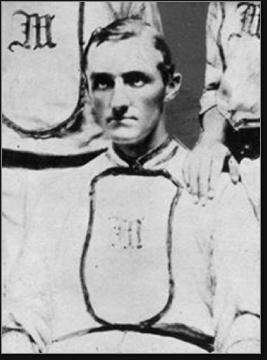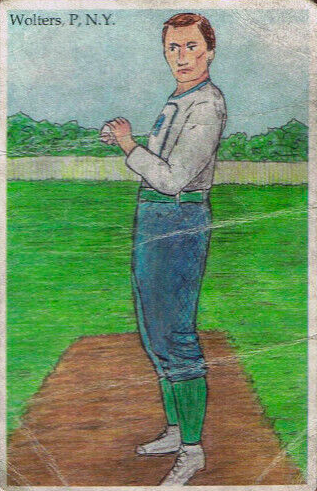
Sport: Baseball
Born: March 17, 1842
Died: January 3, 1917
Town: Newark, New Jersey
weschans in 1846. Some census reports list him as having been born in New Jersey but that appears to be incorrect. Rynie was a tall and wiry boy who gravitated to cricket, which was the most popular team sport in his boyhood days. He was an expert bowler as a teenager and played for several clubs in New Jersey. It was often remarked that he looked much older than his actual age and the few images that exist seem to bear this out.
In addition to cricket, Rynie played the increasingly popular sport of base-ball, which was all the rage in Newark among boys and young men in the late-1850s and 1860s. In 1866, Rynie joined the Irvingtons, one of the most competitive amateur clubs in the country at the time. Among his teammates were fellow Newarkers Charlie Sweasy and Andy Leonard. Their paths would cross multiple times over the next decade.
Rynie developed into a top pitcher in the days when they threw underhand from 45 feet away—and the batter was allowed to call for a high or low ball. Even so, he threw hard and could make the ball rise, much as a submarine pitcher or softball pitcher might today. In 1868, Rynie became the main pitcher for the New York Mutuals, one of the region’s top teams. Among Rynie’s teammates on the Mutuals was another familiar face, John Hatfield, from Hoboken.
In 1869, Rynie faced the Cincinnati Red Stockings on their legendary 57–0 tour of the country. Both Sweasy and Leonard hit against him. The game was historic. In an era of high scores, (the Red Stockings had scored more than 200 runs in their previous five contests), Rynie held Cincinnati to a mere two runs over the first 8 innings. The Mutuals knotted the score 2–2 in the 9th and were poised to score the winning run when the Red Stockings dropped an infield fly on purpose and turned a slick, inning-ending double play; there was no infield fly rule at the time. Cincinnati scored the winning run on a passed ball to escape with the narrowest victory of their tour. Afterwards, the New York newspapers called it the greatest game ever played. In their next five matches—all against strong opponents—the Red Stockings averaged more than 25 runs a game.

In the summer of 1870, pitching again for the Mutuals, Rynie beat the Chicago White Stockings, 9–0. It was one of the first recorded shutouts in professional baseball, and was widely reported as an unprecedented feat. Indeed, for many years thereafter, teams that failed to score were said to be “Chicagoed.”
Rynie was once again the main pitcher for the Mutuals in 1871. It was the first year of the National Association of Professional Base Ball Players, the precursor of the modern National League. He started 32 of their 33 games, went 16–16, and led the NA in innings pitched. Rynie pitched another shutout, a 13–0 win over the Ft. Wayne Kekiongas, a string Midwestern club that beat Al Spalding twice in head-to-head matchups with the Boston Red Stockings that summer. Rynie was one of the NA’s top hitters, too, batting .370 and leading all players with 44 runs driven in.
The Mutuals hired Candy Cummings to be their pitcher in 1872, so Rynie signed to play with the Cleveland Forest Citys. He only pitched in 12 games for Cleveland before being replaced. His young catcher that season was future Hall of Famer Deacon White.
In 1873, Rynie, now in his 30s, was signed by the Elizabeth Resolutes, who had formed a National Association team over the winter—New Jersey’s first. He pitched the season’s opening game and gave up 23 runs in a loss to the Philadelphia Whites. That was Rynie’s last “big-league” appearance. He pitched the rest of the year for a semipro team in Philadelphia and went on to become a produce salesman. He continued to pitch here and there into his mid-30s. He died at the age of 74 in Newark.